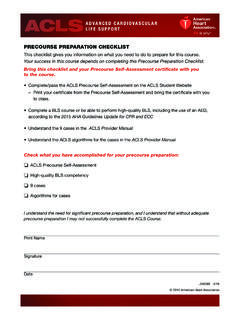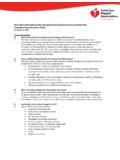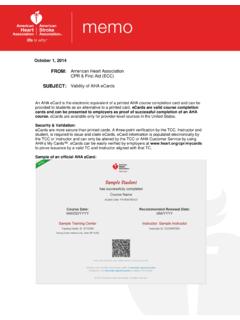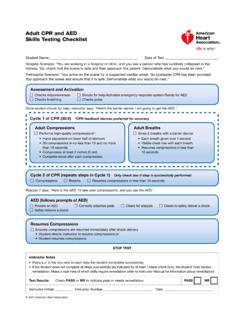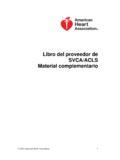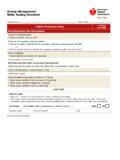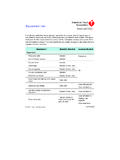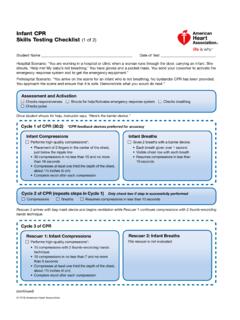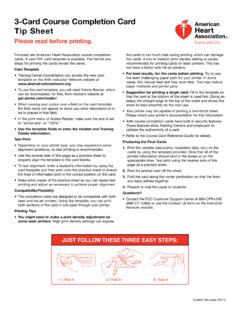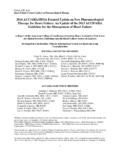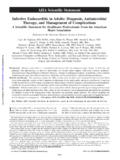Transcription of 2015 Guidelines Open Resource Exams FAQ …
1 2015 Guidelines : open Resource Exams FAQ As of February 16, 2016 Below is the specific language from the AHA s BLS Instructor Manual, pages 31 and 32, about open Resource Exams . This language will be duplicated in all AHA Instructor Manuals as they are released throughout 2016. The exam measures the mastery of cognitive skills. Each student must score at least 84% on the exam to meet course completion requirements. As part of the new education methodologies, the AHA has adopted an open - Resource policy for Exams administered online through an eLearning course and in a classroom-based course. open Resource means that students may use resources for reference while completing the exam. Resources could include the Provider Manual either in printed form or as an eBook on personal devices, any notes the student took during the provider course, the ECC Handbook, the 2015 AHA Guidelines Update for CPR and ECC, posters, etc. open Resource does not mean open discussion with other students or the Instructor.
2 " Q: What are open Resource Exams ? A: As part of new education methodologies, the AHA has adopted an open Resource policy for Exams administered in a classroom-based course or online through an eLearning course. open Resource means that students may use resources for reference while completing the exam. Resources could include the course provider manual either in printed form or as an eBook on personal devices, any notes the student took during the provider course, the 2015 Handbook of ECC, the 2015 AHA Guidelines Update for CPR and ECC, posters, etc. open Resource does not mean open discussion with other students or the Instructor. Q: Why is the AHA moving to open Resource Exams ? A: AHA is moving to open Resource Exams to enhance the way students knowledge and understanding of course concepts is assessed and tested. AHA s primary objective is to ensure students are able to actually save lives after successful course completion. open Resource Exams enable students to use course materials to process information analytically, but also to think independently and creatively.
3 New scenario-based exam questions will challenge students to evaluate real-life situations and use critical-thinking skills to show mastery of course content. open Resource reduce the amount of information the student needs to memorize in preparation for the exam, which in most cases, is forgotten after the exam. open Resource Exams also can be used to differentiate those who truly understand the concepts from those who have merely crammed the night before. Q: When should Instructors begin administering Exams following the open Resource exam policy? A: Instructors may only begin administering open Resource Exams once they receive new Instructor materials and Exams for courses updated to reflect the 2015 AHA Guidelines for CPR and ECC. open Resource testing should not be used for 2010 Guidelines version courses. 2015 Guidelines : open Resource Exams FAQ Q: Does open Resource also apply to course learning stations? A: No. open Resource only applies to written course Exams .
4 For course learning stations, skills will be tested the same way as in current AHA courses, which is that students are allowed to use the course pocket reference guide and algorithm information. Q: I ve heard that the length of/number of questions in the course Exams has increased. Is this accurate? A: The exam for the new BLS Course includes 25 questions, which is the same number as the 2010 Guidelines version BLS exam. For AHA s advanced courses, the AHA has created consistency in the number of test questions. Both ACLS and PALS Exams will now include the same number of questions. Exams in both content and number of questions/length are designed to align with the learning objectives for each course and the level of education of the healthcare provider. Also, a repository of exam questions has been developed that can be used across disciplines to create consistency between courses. Q: Is there a time limit for students to complete course Exams ? A: Since Exams administered are usually for employment purposes, to help ensure equality for all students who take AHA Exams , the AHA does not mandate a time limit for completion.
5 This does not mean that students should be given unlimited time to complete course Exams . The amount of time allotted for taking the course exam can be determined by the AHA Instructor and/or Training Center monitoring the exam process. The course Instructor/Training Center can determine whether a student either does not know the information or may need additional time to successfully complete the exam. Additionally, the AHA has considered the Americans with Disabilities Act (ADA) ADA in the decision not to mandate a course exam time limit. The ADA ensures that individuals with disabilities have the opportunity to fairly compete for and pursue such opportunities by requiring testing entities to offer Exams in a manner accessible to persons with disabilities; when needed testing accommodations are provided, test-takers can demonstrate their true aptitude. When a testing entity provides additional time to a student taking an exam, the entity must do so without either advantaging or disadvantaging any student, disabled or non-disabled.
6
